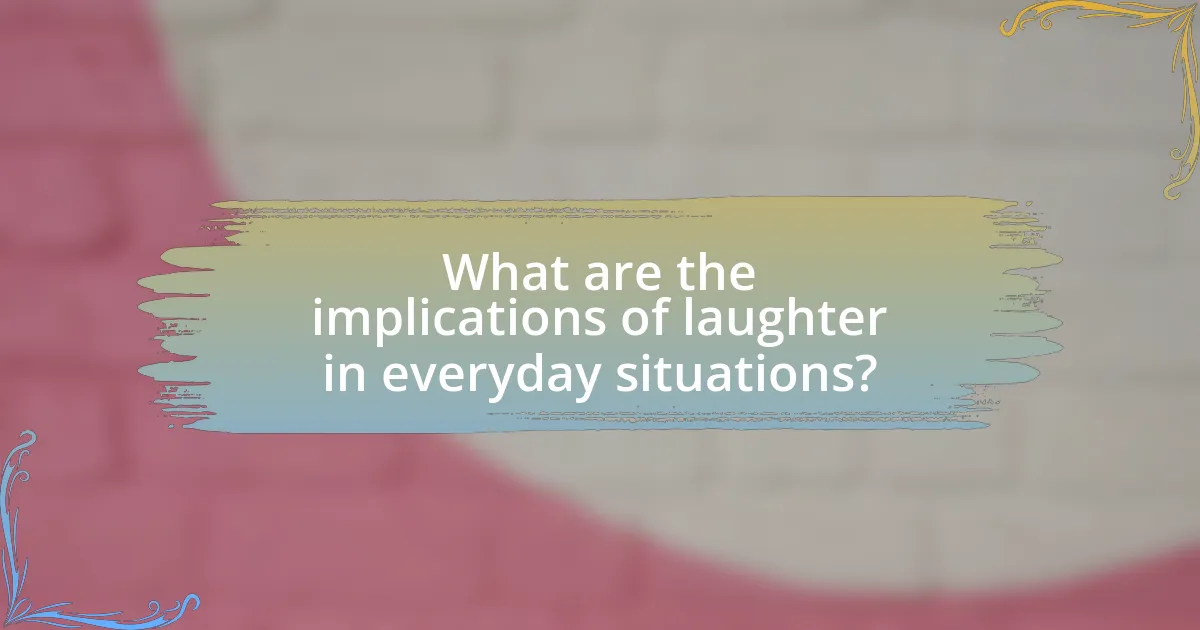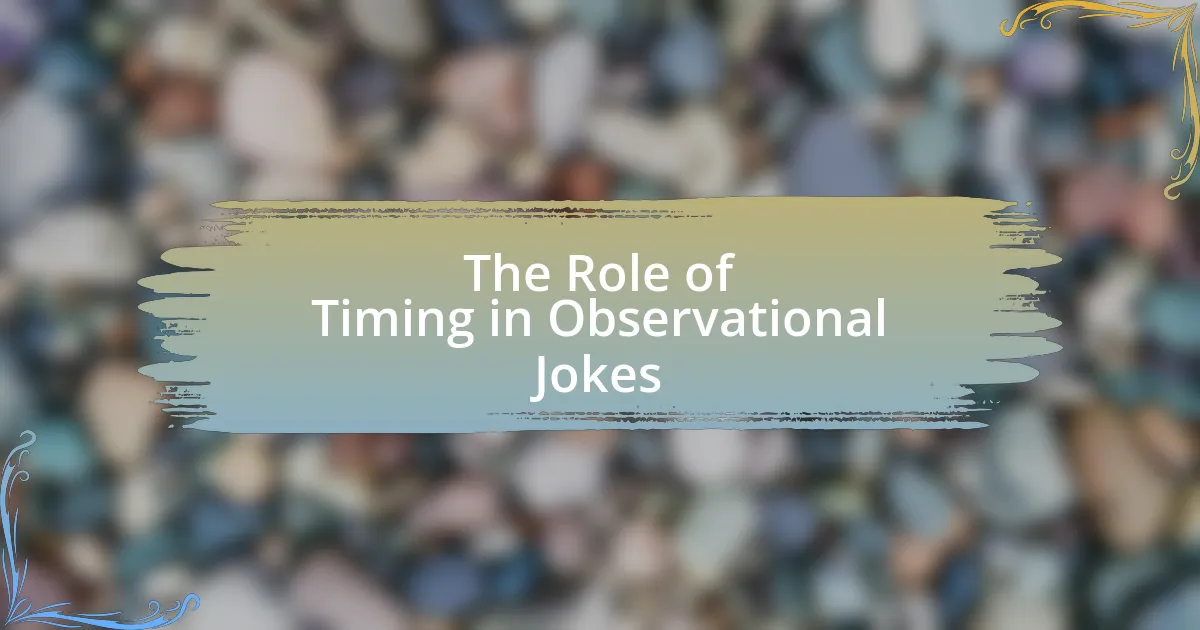The article explores the science behind laughter in mundane situations, focusing on the incongruity theory of humor, which explains how unexpected elements disrupt normal expectations to elicit laughter. It discusses various psychological theories, including Superiority Theory and Relief Theory, that provide insights into why we find humor in everyday occurrences. Additionally, the article examines the role of context, cultural influences, and social interactions in shaping our perception of humor, as well as the physiological and psychological benefits of laughter, such as stress reduction and enhanced social bonding. Overall, it highlights the multifaceted nature of laughter and its significance in everyday life.

What is the Science Behind Why We Laugh at Mundane Situations?
Laughter at mundane situations often arises from incongruity, where unexpected or absurd elements disrupt normal expectations. This phenomenon is supported by the incongruity theory of humor, which posits that humor emerges when there is a discrepancy between what is anticipated and what actually occurs. For instance, a person slipping on a banana peel is humorous because it contrasts with the expected behavior of walking smoothly. Research by psychologists such as Thomas Veatch highlights that laughter serves as a social bonding mechanism, reinforcing group cohesion when individuals share a humorous experience. Additionally, laughter triggers the release of endorphins, promoting feelings of happiness and reducing stress, which further explains why mundane situations can elicit laughter.
How do psychologists define laughter in everyday contexts?
Psychologists define laughter in everyday contexts as a complex physiological and psychological response characterized by vocalizations, facial expressions, and bodily movements that typically occur in response to humor or social interactions. This response serves various functions, including social bonding, stress relief, and communication of emotions. Research indicates that laughter activates brain regions associated with pleasure and reward, reinforcing its role in social cohesion and emotional well-being. For instance, a study published in the journal “Neuroscience & Biobehavioral Reviews” by authors such as Robert Provine highlights how laughter can enhance group dynamics and foster connections among individuals.
What are the psychological theories explaining laughter?
Psychological theories explaining laughter include the Superiority Theory, Incongruity Theory, and Relief Theory. The Superiority Theory posits that laughter arises from the feeling of superiority over others, often seen in humor that highlights someone’s misfortune or mistakes. Incongruity Theory suggests that laughter occurs when there is a discrepancy between expectations and reality, creating a surprise that triggers amusement. Relief Theory, proposed by Sigmund Freud, indicates that laughter serves as a release of psychological tension or pent-up emotions. These theories are supported by various studies, including those by Thomas Hobbes for Superiority Theory, and by researchers like Mikhail Bakhtin for Incongruity Theory, demonstrating the multifaceted nature of laughter in human psychology.
How does context influence our perception of humor?
Context significantly influences our perception of humor by shaping the situational framework in which a joke or comedic scenario is presented. For instance, cultural background, social norms, and the specific environment can determine what is considered funny; a joke that resonates in one culture may fall flat in another due to differing values or experiences. Research indicates that humor often relies on shared knowledge and experiences, meaning that when the context aligns with the audience’s understanding, the humor is more likely to be appreciated. A study published in the journal “Cognitive Science” by authors such as M. J. Ruch and H. J. Hehl demonstrates that contextual cues, including timing and delivery, play crucial roles in how humor is perceived and received.
Why do mundane situations trigger laughter?
Mundane situations trigger laughter primarily due to the incongruity they present, which creates a surprise or unexpected twist in a familiar context. This incongruity theory suggests that humor arises when there is a deviation from the norm, leading to a cognitive shift that elicits laughter. For example, a person slipping on a banana peel is a common trope because it juxtaposes the ordinary act of walking with an unexpected mishap, creating a humorous contrast. Research by psychologists such as Thomas Veatch indicates that humor often stems from the violation of social norms or expectations, reinforcing the idea that laughter is a response to incongruity in everyday life.
What role does incongruity play in humor?
Incongruity plays a central role in humor by creating a mismatch between expectations and reality, which often leads to laughter. This psychological phenomenon occurs when there is a deviation from the norm or an unexpected twist in a situation, prompting a cognitive shift that elicits amusement. Research by Thomas Veatch in “A Theory of Humor” highlights that humor arises when incongruity is resolved, allowing individuals to experience a pleasurable surprise. This mechanism is evident in everyday scenarios where mundane situations are presented in an absurd or unexpected manner, reinforcing the idea that humor often stems from the juxtaposition of contrasting elements.
How does familiarity with a situation affect our response?
Familiarity with a situation significantly influences our response by shaping our expectations and emotional reactions. When individuals encounter familiar scenarios, they often experience a sense of comfort and predictability, which can lead to a more relaxed and open response. Research indicates that familiarity can enhance positive emotions and reduce anxiety, as seen in studies where participants reported higher levels of enjoyment and laughter in familiar contexts compared to unfamiliar ones. For instance, a study published in the Journal of Personality and Social Psychology found that people are more likely to find humor in everyday situations they have previously encountered, reinforcing the idea that familiarity enhances our ability to appreciate and respond to humor in mundane contexts.
What are the physiological effects of laughter?
Laughter triggers a range of physiological effects that positively impact the body. It stimulates the release of endorphins, which are natural painkillers and mood elevators, leading to an enhanced sense of well-being. Additionally, laughter increases blood flow and improves cardiovascular health by promoting vascular function, as evidenced by a study published in the Journal of the American College of Cardiology, which found that laughter can improve endothelial function. Furthermore, laughter engages multiple muscle groups, including those in the face, abdomen, and diaphragm, providing a form of physical exercise. It also reduces levels of stress hormones, such as cortisol, thereby lowering stress and promoting relaxation. These physiological responses collectively contribute to improved mental and physical health.
How does laughter impact our brain chemistry?
Laughter significantly impacts our brain chemistry by triggering the release of neurotransmitters such as dopamine, endorphins, and serotonin. These chemicals enhance mood, promote feelings of pleasure, and reduce stress. Research indicates that laughter activates the brain’s reward system, leading to increased dopamine levels, which are associated with feelings of happiness and motivation. Additionally, laughter reduces cortisol, a stress hormone, thereby promoting relaxation and overall well-being. Studies, such as those conducted by the University of Maryland, have shown that laughter can improve cardiovascular health by increasing blood flow and improving vascular function, further illustrating its positive effects on brain chemistry and overall health.
What are the health benefits associated with laughter?
Laughter provides numerous health benefits, including stress reduction, improved immune function, and enhanced pain tolerance. Research indicates that laughter triggers the release of endorphins, which are natural mood lifters, and can lower levels of stress hormones like cortisol. A study published in the journal “Psychological Science” found that laughter can increase pain tolerance by activating the body’s natural painkillers. Additionally, laughter promotes better cardiovascular health by improving blood flow and enhancing blood vessel function, as evidenced by research from the University of Maryland Medical Center, which showed that laughter can improve endothelial function.

How does cultural context influence laughter at mundane situations?
Cultural context significantly influences laughter at mundane situations by shaping the social norms and values that dictate what is considered humorous. Different cultures have unique interpretations of humor, which can affect how individuals respond to everyday occurrences. For example, in collectivist cultures, laughter may serve as a means of reinforcing group cohesion and shared experiences, while in individualistic cultures, it may be more about personal expression and individual perspective. Research indicates that humor often reflects cultural values; for instance, a study by Martin et al. (2003) found that humor styles vary across cultures, impacting how people perceive and react to mundane situations. Thus, cultural context plays a crucial role in determining the appropriateness and nature of laughter in everyday life.
What cultural factors shape our sense of humor?
Cultural factors that shape our sense of humor include language, social norms, historical context, and shared experiences. Language influences humor through wordplay, puns, and idiomatic expressions that resonate within specific cultures. Social norms dictate what is considered acceptable or taboo, affecting the types of jokes that are made and appreciated. Historical context provides a backdrop for humor, as events and societal changes can create shared references that enhance comedic understanding. Shared experiences, such as regional customs or collective memories, foster a sense of community that can amplify humor. For example, research by the University of California found that humor often reflects cultural values and societal structures, indicating that humor is not universally understood but rather shaped by the cultural environment in which it exists.
How do different cultures interpret mundane humor?
Different cultures interpret mundane humor through their unique social norms, values, and linguistic nuances. For instance, in Western cultures, humor often derives from irony and self-deprecation, reflecting individualism and personal experiences. In contrast, many Asian cultures may emphasize humor that fosters group harmony and avoids direct confrontation, often using subtlety and wordplay. Research indicates that cultural context significantly shapes humor appreciation; for example, a study by Martin et al. (2003) found that humor styles vary across cultures, with collectivist societies favoring humor that promotes social cohesion. This illustrates that the interpretation of mundane humor is deeply rooted in cultural frameworks, influencing what is considered funny and how humor is expressed.
What examples illustrate cultural differences in laughter?
Cultural differences in laughter can be illustrated through variations in social contexts and expressions. For instance, in Western cultures, laughter often serves as a social bonding mechanism and is frequently used in casual conversations, while in some Asian cultures, laughter may be more subdued and used to express politeness or to mask discomfort. Research by Robert Provine in “Laughter: A Scientific Investigation” highlights that laughter in different cultures can convey distinct meanings, such as joy, embarrassment, or even a way to defuse tension. Additionally, a study published in the journal “Cultural Psychology” by Matsumoto and Hwang indicates that laughter in collectivist societies tends to be more restrained compared to the more expressive laughter found in individualistic societies. These examples underscore how laughter is not only a universal human behavior but also deeply influenced by cultural norms and values.
How does social interaction affect laughter in everyday life?
Social interaction significantly enhances laughter in everyday life by creating shared experiences that trigger humor. When individuals engage socially, they often find themselves in situations that foster a sense of connection and amusement, leading to laughter as a natural response. Research indicates that laughter is more frequent in group settings, as social dynamics amplify the perception of humor. For instance, a study published in the journal “Psychological Science” by Robert Provine found that people are 30 times more likely to laugh in social contexts than when alone, highlighting the role of social interaction in eliciting laughter. This phenomenon occurs because laughter serves as a social bonding mechanism, reinforcing relationships and promoting a sense of belonging among individuals.
What role does group dynamics play in humor appreciation?
Group dynamics significantly influence humor appreciation by shaping social interactions and collective responses to humor. In group settings, shared experiences and social bonds enhance the enjoyment of humor, as individuals often find jokes funnier when they are part of a cohesive group. Research indicates that laughter is contagious; for instance, a study published in the journal “Psychological Science” found that people are more likely to laugh when they are in the presence of others laughing, demonstrating the social reinforcement of humor. Additionally, group norms and cultural context play a crucial role, as humor that aligns with the group’s values and experiences is more readily appreciated. Thus, group dynamics create an environment where humor can thrive, fostering a shared sense of enjoyment and connection among individuals.
How does laughter strengthen social bonds?
Laughter strengthens social bonds by fostering a sense of connection and shared experience among individuals. When people laugh together, it triggers the release of endorphins, which promote feelings of happiness and reduce stress, thereby enhancing interpersonal relationships. Research indicates that laughter activates the brain’s reward system, reinforcing social ties and encouraging cooperative behavior. A study published in the journal “Emotion” by authors such as Robert R. Provine highlights that laughter serves as a social signal, facilitating communication and bonding in group settings. This biological and psychological response to laughter underscores its role in creating and maintaining social cohesion.

What are the implications of laughter in everyday situations?
Laughter in everyday situations serves as a social bonding mechanism and a stress reliever. It fosters connections among individuals, enhancing group cohesion and promoting a sense of belonging. Research indicates that laughter triggers the release of endorphins, which are chemicals in the brain that promote feelings of happiness and reduce stress. For instance, a study published in the journal “Psychological Science” found that laughter can improve interpersonal relationships and increase feelings of trust and cooperation among individuals. Thus, laughter not only enriches social interactions but also contributes to emotional well-being.
How can understanding laughter improve communication?
Understanding laughter can significantly improve communication by enhancing interpersonal connections and reducing tension. Laughter serves as a social signal that fosters bonding and indicates shared understanding, which can lead to more effective exchanges. Research shows that laughter activates the brain’s reward system, promoting feelings of happiness and trust among individuals, thereby facilitating open dialogue. For instance, a study published in the journal “Psychological Science” found that laughter can increase cooperation and empathy in group settings, demonstrating its role in improving communication dynamics.
What strategies can enhance humor in daily interactions?
To enhance humor in daily interactions, individuals can employ strategies such as observational humor, playful teasing, and the use of puns. Observational humor involves noticing and commenting on the absurdities of everyday life, which can create a shared sense of amusement. Playful teasing, when done in a light-hearted manner, fosters camaraderie and can elicit laughter without offending others. The use of puns, or wordplay, can also introduce humor by creating unexpected connections between words and meanings. Research indicates that humor can strengthen social bonds and improve communication, as demonstrated in a study published in the Journal of Personality and Social Psychology, which found that shared laughter enhances relationship satisfaction.
How can laughter be used to diffuse tension in mundane situations?
Laughter can diffuse tension in mundane situations by triggering the release of endorphins, which promote feelings of well-being and reduce stress. This physiological response helps to create a more relaxed atmosphere, making it easier for individuals to navigate uncomfortable or awkward moments. Research indicates that laughter can lower cortisol levels, a hormone associated with stress, thereby fostering a sense of connection and camaraderie among people. For instance, a study published in the journal “Psychological Science” found that shared laughter can enhance social bonds and improve group dynamics, effectively alleviating tension in everyday interactions.
What practical tips can enhance our appreciation of humor in mundane situations?
To enhance appreciation of humor in mundane situations, individuals can practice mindfulness to become more aware of their surroundings and recognize humorous elements. Mindfulness encourages observation of everyday life, allowing people to notice absurdities or quirks that often go unnoticed. Additionally, adopting a playful mindset can help individuals reframe ordinary experiences as opportunities for humor. Research indicates that humor can be a coping mechanism, and viewing mundane tasks through a humorous lens can reduce stress and increase enjoyment. Engaging in social interactions that promote laughter, such as sharing funny stories or jokes, can also enhance the perception of humor in daily life.





